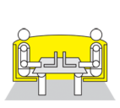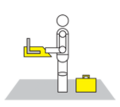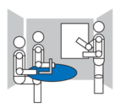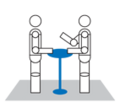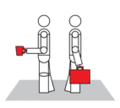Office
This article may require copy editing for grammar, style, cohesion, tone, or spelling. (February 2023) |

An office is a space where the
Offices were, in

The main purpose of an office building is to provide a working environment for primarily administrative and managerial workers.
History

The word "office" stems from the Latin
Offices in classical antiquity were often part of a palace complex or a large temple. There was often a room where
Middle Ages

The High Middle Ages (1000–1300) saw the rise of the medieval chancery, which was the place where most government letters were written and laws were copied within a kingdom. The rooms of the chancery often had walls full of pigeonholes, constructed to hold rolled-up pieces of parchment for safekeeping or ready reference—a precursor to the bookshelf. The introduction of printing during the Renaissance did not impact the setup and function of these government offices significantly.
Medieval paintings and tapestries often show people in their private offices handling record-keeping books or writing on scrolls of parchment. Before the invention of the printing press and its wider distribution, there was often a very thin line between a private office and a private library because books were both read and written at the same desk or table, as were personal and professional accounting and letter-writing.
It was during the 13th century that the English word "office" first appeared when referring to a position involving specific professional duties (ex. the office of the ...). Geoffrey Chaucer appears to have first used the word in 1395 to mean a place where business is transacted in The Canterbury Tales.
As mercantilism became the dominant economic theory of the Renaissance, merchants tended to conduct their business in buildings that might also house people doing retail sales, warehousing, and clerical work. During the 15th century, population density in many cities reached the point where stand-alone buildings were used by merchants to conduct their business, and there was a developing distinction between church, government/military, and commerce uses for buildings.[2]
The emergence of the modern office
With the growth of large organizations such as the

The East India House was built in 1729 on Leadenhall Street as the headquarters from which the East India Company administered its Indian colonial possessions. The Company developed a very complex bureaucracy for the task, which required thousands of office employees to process the necessary paperwork. The Company recognized the benefits of centralized administration and required that all workers sign in and out at the central office each day.[4]
As the
The relatively high price of land in the central core of cities led to the first multi-story buildings, which were limited to about 10 stories until the use of
20th century

By 1906,
However, by the midpoint of the 20th century, it became apparent that an efficient office required discretion in the control of privacy, which is needed to combat tedium linked to poor productivity and encourage creativity. In 1964, the
Japan 20th century office
This section needs additional citations for verification. (October 2020) |
Japanese businesses have set themselves apart from their American counterparts by implementing different techniques in the way they handle business. The Japanese office layout improves work productivity, creates harmony in the office, and holds every employee accountable for the work they produce. The type of office layout used in Japan is called an open plan and relies on ergonomics to help make employees as productive as possible. The Japanese open office layout allows them to use an organizational structure known as the horizontal structure. In the typical Japanese office, there are no walls dividing desks, no cubicles, and no individual offices. Also, they are able to implement policies using the ringi-sho consensus.
In order to get group members to work effectively in the open office floor plan, island-style desks are used. The most dominant feature of the Japanese island-style office layout is that each group forms an island. Kageyu Noro, Goroh Fujimaki, and Shinsuke Kishi, researchers of ergonomics in the workplace, stated, "Japanese offices have traditionally adhered to island layouts because these reflect the Japanese style of teamwork and top-down management."[7] The group leader will then sit in the prominent position and ensure productivity.

The group leader will assign a task to the group, and each member of the group then receives their individual task to complete. Island-style seating also gives the group the benefit of being able to speak to one another at any time and ask for help if needed. Being in such close proximity to one another in the office gives another advantage to the supervisor in that he can call an uchi-awase. Uchi-awase is an informal meeting in order to get an important message across, and also allows all members of the team to be creative in the office. "The open office layout allows for this because there are hardly any independent rooms or enclosures. If the supervisor stands at his desk he can glance at his associates and easily call them over.", according to Durlabhji, Subhash, Norton E. Marks, and Scott Roach, authors of Japanese Business: Cultural Perspective.[8] Once all individual tasks are complete the group then combines each person's work and the project is put together as a whole and returned to the supervisor. The work is viewed as a team effort and each member of the group receives equal credit for being part of a team completing the goal assigned. The group itself holds each member accountable for ensuring that the work is getting done and that no one individual is doing more work than another. Another motivating factor is that the group's boss is also seated at the same desk, and the effect that this has on the individuals is that they must work hard just like the boss. The role of having an open layout with island-type seating allows the office to be structured so the employees are put together as teams.
The type of organizational structure found within the Japanese office is known as a horizontal structure. According to Andrew, Ghillyer, author of Management Now, "Horizontal structure is an organization structure consisting of two groups: the first composed of senior management responsible for strategic decisions and policies and the second composed of empowered employees working together in different process teams; also known as a team structure."[9] The benefit of using this type of structure is that hierarchy is flattened to reduce supervision, teams are able to self-manage, team performance, not just the individual is rewarded, and training is highly emphasized amongst all employees. With a heightened sense of empowerment and responsibility workers are motivated to complete objectives in a timely manner. Having the office structured horizontally allows for easy communication of introducing new policies and ideas among the groups.
"Ringisho" is the concept of submitting proposals and making decisions off those ideas. By unifying everyone together in the Japanese office it helps to make better-informed decisions on the policies of the company that all managers and employees have input on. The idea behind this is to get a hold of various thinking individuals to see if there is a good way in writing their policies that come to benefit the company better. Richard Lewis, the author of When Cultures Collide, states "Suggestions, ideas and inventions make their way up the company hierarchy by a process of collecting signatures among workers and middle managers. Many people are involved. Top executives take the final step in ratifying items that have won sufficient approval."[10] With this system in place changes to policies are only passed if there is an overall consensus to pass it. Allowing each group to have a say on which policies should be implemented improves overall job satisfaction and harmony throughout the office.
The way Japanese offices are structured allow them to be more efficient when conducting business. The efficiency at which they operate has been noticed by such companies as General Motors, Ford, Motorola, and Chrysler Company. They continue to look for other ways to be more efficient and productive with the office layout and employee productivity.
Office spaces
The main purpose of an office environment
Workspaces
Workspaces in an office are typically used for conventional office activities such as reading, writing, and computer work. There are nine generic types of workspaces, each supporting different activities.
-
Open office
-
Team space
-
Cubicle
Open office: An open workspace for more than ten people; suitable for activities that demand frequent communication or routine activities that need relatively little concentration.
Team space: A semi-enclosed workspace for two to eight people; suitable for teamwork which demands frequent internal communication and a medium level of concentration.
Cubicle: A semi-enclosed workspace for one person; suitable for activities that demand medium concentration and medium interaction.
-
Private office
-
Shared office
-
Team room
Private office: An enclosed workspace for one person; suitable for activities that are confidential, demand a lot of concentration, or include many small meetings.
Shared office: A compact, semi-private workspace designed for two or three individuals, facilitating both focused work and small group collaboration.
Team room: An enclosed workspace for four to ten people; suitable for teamwork that may be confidential and demands frequent internal communication.
-
Study booth
-
Work lounge
-
Touch down
Study booth: An enclosed workspace for one person; suitable for short-term activities that demand concentration or confidentiality.
Work lounge: A lounge-like workspace for two to six people; suitable for short-term activities that demand collaboration and/or allow impromptu interaction.
Touch down: An open workspace for one person; suitable for short-term activities that require little concentration and low interaction.
Meeting spaces
Meeting spaces in an office typically use interactive processes, be they quick conversations or intensive brainstorming. There are six generic types of meeting spaces, each supporting different activities.
-
Small meeting room
-
Large meeting room
-
Small meeting space
Small meeting room: An enclosed meeting space for two to four people; suitable for both formal and informal interaction.
Large meeting room: An enclosed meeting space for five to twelve people; suitable for formal interaction.
Small meeting space: An open or semi-open meeting space for two to four persons; suitable for short, informal interaction.
-
Large meeting space
-
Brainstorm room
-
Meeting point
Large meeting space: An open or semi-open meeting space for five to twelve people; suitable for short, informal interaction.
Brainstorm room: An enclosed meeting space for five to twelve people; suitable for brainstorming sessions and workshops.
Meeting point: An open meeting point for two to four people; suitable for ad hoc, informal meetings.
Support spaces
Support spaces in an office are typically used for secondary activities such as filing documents or taking a break. There are twelve generic types of support spaces, each supporting different activities.
-
Filing space
-
Storage space
-
Print and copy area
Filing space: An open or enclosed support space for the storage of frequently used files and documents
Storage space: An open or enclosed support space for the storage of commonly used office supplies
Print and copy area: An open or enclosed support space with facilities for printing, scanning and copying
-
Mail area
-
Pantry area
-
Break area
Mail area: An open or semi-open support space where employees can pick up or deliver their mail
Pantry area: An open or enclosed support space where employees can get refreshments and supplies for visitor hospitality are kept.
Break area: A semi-open or enclosed support space where employees can take a break from their work
-
Locker area
-
Smoking room
-
Library
Locker area: An open or semi-open support space where employees can store their personal belongings
Smoking room: An enclosed support space where employees can smoke a cigarette
Library: A semi-open or enclosed support space for reading books, journals and magazines
-
Games room
-
Waiting area
-
Circulation space
Games room: An enclosed support space where employees can play games (e.g., computer games, pool, darts)
Lactation room: as of the 2010 Patient Protection and Affordable Care Act, a requirement for companies in the United States.
Waiting area: An open or semi-open support space where visitors can be received and wait for their appointment
Circulation space: Support space which is required for circulation on office floors, linking all major functions
Office structure
There are many different ways of arranging the space in an office and whilst these vary according to function, managerial fashions, and the culture of specific companies can be even more important. Choices include, how many people will work within the same room. At one extreme, each individual worker will have their own room; at the other extreme a large open plan office can be made up of one main room with tens or hundreds of people working in the same space. Open-plan offices put multiple workers together in the same space, and some studies have shown that they can improve short-term productivity, i.e. within a single software project. At the same time, the loss of privacy and security can increase the incidence of theft and loss of company secrets. A type of compromise between open plan and individual rooms is provided by the cubicle desk, possibly made most famous by the Dilbert cartoon series, which solves visual privacy to some extent, but often fails on acoustic separation and security. Most cubicles also require the occupant to sit with their back towards anyone who might be approaching; workers in walled offices almost always try to position their normal work seats and desks so that they can see someone entering, and in some instances, install tiny mirrors on things such as computer monitors.
According to research, open-plan offices, associated with a 70% decrease in face-to-face interactions and a rise in electronic communication, result in increased stress, a 25% uptick in negative moods, and up to a 20% drop in productivity due to distractions. In contrast, post-pandemic trends are favoring private "cell-office plans," which address health precautions and have been reported to enhance productivity by up to 22%.[12][13][14]
Office buildings



While offices can be built in almost any location and in almost any building, some modern requirements for offices make this more difficult. These requirements can be both legal (e.g., light levels must be sufficient) or technical (e.g., requirements for computer networking). Alongside, other requirements such as security and flexibility of layout, has led to the creation of special
The primary purpose of an office building is to provide a workplace and working environment primarily for administrative and managerial workers. These workers usually occupy set areas within the office building, and usually are provided with desks, PCs and other equipment they may need within these areas.
An office building will be divided into sections for different companies or may be dedicated to one company. In either case, each company will typically have a reception area, one or several meeting rooms, singular or open-plan offices, as well as toilets.
Many office buildings also have kitchen facilities and a staff room, where workers can have lunch or take a short break. Many office spaces are now also serviced office spaces, which means that those occupying a space or building can share facilities.
Office and retail rental rates
Rental rates for office and retail space are typically quoted in terms of money per floor-area–time, usually money per floor-area per year or month. For example, the rate for a particular property may be $29 per square-foot per year ($29/s.f/yr) - $290 per square-meter–year ($290/m2/a), and rates in the area could range $20–$50/s.f./yr ($200–$500/m2·a).
In many countries, rent is typically paid monthly even if usually discussed in terms of years.
Examples:
- A particular 2,000 s.f. space is priced at $15/s.f./yr = (2,000 s.f.) × ($15/s.f./a) / (12 mo/yr) = $2500/month
- A 200 m2 space priced at $150/m2·a = (200 m2) × ($150/m2·a) / (12 mo/a) = $2500/month
In a gross lease, the rate quoted is an all-inclusive rate. One pays a set amount of rent per time and the landlord is responsible for all other expenses such as costs of utilities, taxes, insurance, maintenance, and repairs.
The triple net lease is one in which the tenant is liable for a share of various expenses such as property taxes, insurance, maintenance, utilities, climate control, repairs, janitorial services and landscaping.
Office rents in the United States are still recovering from the high vacancy rates that occurred in the wake of the 2008 depression.[15]
Grading
The Building Owners and Managers Association (BOMA) classifies office space into three categories: Class A, Class B, and Class C.[16] According to BOMA, Class A office buildings have the "most prestigious buildings competing for premier office users with rents above average for the area". BOMA states that Class A facilities have "high-quality standard finishes, state of the art systems, exceptional accessibility and a definite market presence". BOMA describes Class B office buildings as those that compete "for a wide range of users with rents in the average range for the area". BOMA states that Class B buildings have "adequate systems" and finishes that "are fair to good for the area", but that the buildings do not compete with Class A buildings for the same prices. According to BOMA Class C buildings are aimed towards "tenants requiring functional space at rents below the average for the area".[17] The lack of specifics allows considerable room for "fudging" the boundaries of the categories. Oftentimes, the above categories are further modified by adding the plus or minus sign to create subclasses, such as Class A+ or Class B-.[18]
See also
|
|
References
- ^
ISBN 9781847650658. Retrieved 2018-09-08.
[...] the Modern Efficiency Desk, first made in 1915 by Steelcase Inc. for the New York offices of Equitable Assurance. This desk, consisting of a simple, rectangular table with small drawers, replaced the cabinet-like desks, with their high backs made up of little drawers and cubby holes, which dominated office life before the First World War. At their new efficiency desks, office workers could be watched, monitored and subjected to time-and-motion studies.
- ^ ISBN 978-0975552407.
- ISBN 9781139496544. Archivedfrom the original on 2016-06-17.
- ^ "How the office was invented". BBC. Archived from the original on 2013-07-22. Retrieved 2012-12-17.
- ^ "Liverpool Firsts". Archived from the original on 2013-12-20. Retrieved 2012-12-17.
- ^ "Psychology of the Office Space". University of Southern California Master of Science in Applied Psychology. Archived from the original on 27 January 2015. Retrieved 28 January 2015.
- S2CID 32155122.
- ISBN 9780791412527.
- ISBN 9780071315265.
- ISBN 9781904838029.
- ^ "Office Environment | NIOSH | CDC". www.cdc.gov. 2022-12-08. Retrieved 2023-11-15.
- ^ Haden, Jeff (Jan 14, 2022). "Open Plan Offices Aren't Just the 'Dumbest Management Fad of All Time.'". inc.com. Archived from the original on January 14, 2022. Retrieved Sep 7, 2023.
- ^ Sarkis, Stephanie (Jan 17, 2021). "Post-Pandemic: Fight For An End To The Open-Plan Office". forbes.com. Archived from the original on January 18, 2021. Retrieved Sep 7, 2023.
- ^ Sander, Libby (Jul 6, 2021). "The surprising toll open-plan offices have on our mental health". World Economic Forum. Archived from the original on July 6, 2021. Retrieved Sep 7, 2023.
- ^ "This Recovery Explained" (PDF). The Steven L. Newman Real Estate Institute. Spring 2011. Archived (PDF) from the original on 2013-05-17.
- ^ Kennedy Smith (30 June 2006). "Categorization of office space is flexible". St. Louis Daily Record & St. Louis Countian. Retrieved 9 September 2010.
- ^ "Building Class Definitions". Archived from the original on 27 August 2013. Retrieved 18 July 2013.
- ^ "CLASS A+ OFFICE SPACE" (PDF). cbre.us. Archived (PDF) from the original on 9 October 2016. Retrieved 21 September 2016.
Further reading
- Adams, Scott (2002). What do you call a sociopath in a cubicle? (answer, a coworker). Kansas City, Missouri: Andrews McMeel Pub.
- Duffy, Francis; Cave, Colin; Worthington, John, eds. (1976). Planning Office Space. London: The Architectural Press Ltd.
- Klein, Judy Graf (1982). The Office Book. New York: Facts on File Inc. ISBN 9780871964991.
- van Meel, Juriaan; Martens, Yuri; van Ree, Hermen Jan (2010). Planning Office Spaces: a practical guide for manager and designers. London: Laurence King Publishing.
- Saval, Nikil (2014). Cubed: A Secret History of the Workplace. Doubleday.
- Roderick, Ian (2016). "Representing affective labour and gender performativity in knowledge work: a multimodal critical discourse analysis". .








